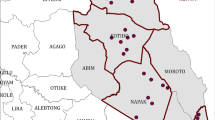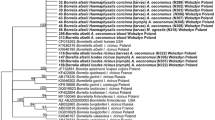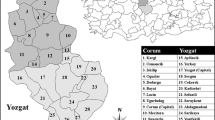Abstract
Hard ticks are the vectors of many pathogens including tick-borne encephalitis virus and the Lyme disease agent Borrelia burgdorferi sensu lato. In Eastern Siberia, Ixodes persulcatus, Dermacentor nuttalli, Dermacentor silvarum and Haemaphysalis concinna are regarded as aggressive to humans. Recently, significant changes in world tick fauna have been reported and this affects the spread of tick-borne pathogens. We studied the current species diversity, population structure and prevalence of tick-borne pathogens of hard ticks (Acari: Ixodidae) that attacked humans in Eastern Siberia (Irkutsk region, Russia). In total, 31,892 individual ticks were identified and analysed during the years 2007–2014. The majority (85.4 %) of victims was bitten by I. persulcatus, 14.55 % of attacks on humans were caused by D. nuttalli and D. silvarum, whereas H. concinna was documented only in 15 cases (0.05 %). The seasonal activity and the age/gender structure of the tick population were studied as well. Among all the studied ticks, three unconventional species, i.e. Rhipicephalus sanguineus, Dermacentor reticulatus and Amblyomma americanum, were identified. Analysis of tick bite histories indicates at least three events of invasion of non-endemic ticks into the ecosystems of northern Eurasia with harsh continental climates. Invading ticks are able to reach the adult life stage and are aggressive to the local human population. Phylogenetic analysis of mt 16S rRNA gene fragments suggests multiple independent routes of tick migration to Eastern Siberia. Possible implications to human health and epidemiology of tick-borne infections are discussed.




Similar content being viewed by others
References
Alström P, Ssaitoh T, Williams D, Nishiumi I, Shigeta Y, Ueda K, Irestedt M, Björklund M, Olson U (2011) The Arctic warbler Phylloscopus borealis—three anciently separated cryptic species revealed. Ibis 153(2):395–410
Beugnet F, Kolasinski M, Michelangeli PA, Vienne J, Loukos H (2011) Mathematical modelling of the impact of climatic conditions in France on Rhipicephalus sanguineus tick activity and density since 1960. Geospat Health 5(2):255–63
Black WC, Piesman J (1994) Phylogeny of hard- and soft-tick taxa (Acari: Ixodida) based on mitochondrial 16S rDNA sequences. Proc Natl Acad Sci U S A 91:10034–8
Childs JE, Paddock CD (2003) The ascendancy of Amblyomma americanum as a vector of pathogens affecting humans in the United States. Annu Rev Entomol 48:307–37
Danchinova GA, Khasnatinov MA, Zlobin VI, Kozlova IV, Verkhozina MM, Sountsova OV, Shulunov SS, Abmed D, Bataa J, Bat-Ochir D, Tsend N, Badueva LN, Lisak OV, Gorina MO (2006) Ixodid ticks in the southern part of Eastern Siberia and Mongolia and their spontaneous infectiveness by infectious agents. Bull Sib Med 5(S1):137–43, in Russian
Dantas-Torres F (2010) Biology and ecology of the brown dog tick, Rhipicephalus sanguineus. Parasit Vectors 3:26
Dantas-Torres F, Latrofa MS, Annoscia G, Giannelli A, Parisi A, Otranto D (2013) Morphological and genetic diversity of Rhipicephalus sanguineus sensu lato from the New and Old Worlds. Parasit Vectors 6:213
Dantas-Torres F, Otranto D (2015) Further thoughts on the taxonomy and vector role of Rhipicephalus sanguineus group ticks. Vet Parasitol 208(1–2):9–13
Deardorff ER, Nofchissey RA, Cook JA, Hope AG, Tsvetkova A, Talbot SL, Ebel GD (2013) Powassan virus in mammals, Alaska and New Mexico, U.S.A., and Russia, 2004–2007. Emerg Infect Dis 19(12):2012–6
Donoso Mantke O, Schädler R, Niedrig M (2008) A survey on cases of tick-borne encephalitis in European countries. Euro Surveill 13(17):pii=18848. Available online: http://www.eurosurveillance.org/ViewArticle.aspx?ArticleId=18848
Ehrlich P, Dobkin D, Wheye D (1988) The birder’s handbook: a field guide to the natural history of North American birds. Simon and Schuster Inc., New York
Emelyanova ND, Boyarkin IV, Sokolov GА, Golotsevich NF, Vershinina TA (1985) To the study of ixodid ticks of Eastern Siberia. In: Land arthropods of Siberia and the Far East, Irkutsk: 134–7, in Russian
Estrada-Peña A (2008) Climate, niche, ticks, and models: what they are and how we should interpret them. Parasitol Res 103(Suppl 1):S87–95
Filippova NA (1977) Ixodid ticks of the subfamily Ixodinae. In: Fauna of Russia and adjacent countries. Arachnida. Leningrad, Nauka 4(4), p 396, in Russian.
Filippova NA (1997) Ixodid ticks of the subfamily Amblyomminae. The fauna of Russia, vol 4. Nauka, St Petersburg, p 436, in Russian
Gill RE, Tibbitts TL, Douglas DC, Handel CM, Mulcahy DM, Gottschalck JC, Warnock N, McCaffery BJ, Battley PF, Piersma T (2009) Extreme endurance flights by landbirds crossing the Pacific Ocean: ecological corridor rather than barrier? Proc Biol Sci 276(1656):447–57
Goddard J, Norment BR (2006) A guide to the ticks of Mississippi. Mississippi State University: Mississippi Agricultural & Forestry Experiment Station, p 20
Gray JS, Dautel H, Estrada-Pena A, Kahl O, Lindgren E (2009) Effects of climate change on ticks and tick-borne diseases in Europe. Interdiscip Perspect Infect Dis 2009:12
Hall TA (1999) BioEdit: a user-friendly biological sequence alignment editor and analysis program for Windows 95/98/NT. Nucl Acids Symp 41:95–8
Hubalek Z (2009) Epidemiology of Lyme borreliosis. Curr Probl Dermatol 37:31–50
Hubálek Z, Rudolf I (2012) Tick-borne viruses in Europe. Parasitol Res 111(1):9–36
Ismail N, Bloch KC, McBride JW (2010) Human ehrlichiosis and anaplasmosis. Clin Lab Med 30(1):261–92
Jaenson TG, Jaenson DG, Eisen L, Petersson E, Lindgren E (2012) Changes in the geographical distribution and abundance of the tick Ixodes ricinus during the past 30 years in Sweden. Parasit Vectors 5:8
Khasnatinov MA, Lyapunov АV, Danchinova GA, Chaporgina ЕА, Arbatskaya ЕV, Tunik TV, Petrova IV (2012) Tick-borne encephalitis: the incidence and prevention of preclinical infection among victims bitten by Ixodid ticks. Epidemiol Inf Dis Current Items 5:19–24, in Russian
Kolonin GV (1981) World distribution of ixodid ticks (genus Ixodes). Nauka, Moscow, p 114, in Russian
Kolonin GV (2009) Fauna of ixodid ticks of the world (Acari, Ixodidae). Moscow. http://www.kolonin.org/1.html. Accessed 10 March 2015
Korenberg E, Likhacheva T (2006) Analysis of the long-term dynamics of tick-borne encephalitis (TBE) and ixodid tick-borne borrelioses (ITBB) morbidity in Russia. Int J Med Microbiol 296(S1):54–8
Korenberg EI, Lebedeva NN (1969) Distribution and some general features of the ecology of Ixodes trianguliceps Bir. in the Soviet Union. Folia Parasitol 16:143–52
Krechmer AV, Andreev AV, Kondratev AY (1978) Ecology and distribution of Sandhill Cranes in northeastern USSR. In: Ecology and distribution of birds in north-eastern USSR. Science Publishers: 140–142.
Leonova GN, Kondratov IG, Ternovoi VA, Romanova EV, Protopopova EV, Chausov EV, Pavlenko EV, Ryabchikova EI, Belikov SI, Loktev VB (2009) Characterisation of Powassan viruses from Far Eastern Russia. Arch Virol 154(5):811–20
Lv J, Wu S, Zhang Y, Chen Y, Feng C, Yuan X, Jia G, Deng J, Wang C, Wang Q, Mei L, Lin X (2014) Assessment of four DNA fragments (COI, 16S rDNA, ITS2, 12S rDNA) for species identification of the Ixodida (Acari: Ixodida). Parasit Vectors 7:93
Mal’kova MG, Iakimenko VV, Tantsev AK (2012) Changes in the ranges of pasture ixodid ticks of the genus Ixodes Latr., 1795 (Parasitiformes, Ixodinae) in Western Siberia. Parazitologiia 46(5):369–83, in Russian
Mangold AJ, Bargues MD, Mas-Coma S (1998) Mitochondrial 16S rDNA sequences and phylogenetic relationships of species of Rhipicephalus and other tick genera among Metastriata (Acari: Ixodidae). Parasitol Res 84(6):478–84
Medlock JM, Hansford KM, Bormane A, Derdakova M, Estrada-Peña A, George JC, Golovljova I, Jaenson TG, Jensen JK, Jensen PM, Kazimirova M, Oteo JA, Papa A, Pfister K, Plantard O, Randolph SE, Rizzoli A, Santos-Silva MM, Sprong H, Vial L, Hendrickx G, Zeller H, Van Bortel W (2013) Driving forces for changes in geographical distribution of Ixodes ricinus ticks in Europe. Parasit Vectors 6:1
Merten HA, Durden LA (2000) A state-by-state survey of ticks recorded from humans in the United States. J Vector Ecol 25:102–13
Moraes-Filho J, Marcili A, Nieri-Bastos FA, Richtzenhain LJ, Labruna MB (2011) Genetic analysis of ticks belonging to the Rhipicephalus sanguineus group in Latin America. Acta Trop 117(1):51–5
Nava S, Mastropaolo M, Venzal JM, Mangold AJ, Guglielmone AA (2012) Mitochondrial DNA analysis of Rhipicephalus sanguineus sensu lato (Acari: Ixodidae) in the Southern Cone of South America. Vet Parasitol 190(3–4):547–55
Nosek J (1971) The ecology, bionomics and behaviour of Haemaphysalis (Haemaphysalis) concinna tick. Z Parasitenkd 36(3):233–41
Sanitary rules SP3.1.3.2352-08 (2008) Prevention of tick-borne viral encephalitis. Federal Service for Supervision of Consumer Rights Protection and Human Welfare, Moscow, p 20, in Russian.
Scott JD, Fernando K, Banerjee SN, Durden LA, Byrne SK, Banerjee M, Mann RB, Morshed MG (2001) Birds disperse ixodid (Acari: Ixodidae) and Borrelia burgdorferi-infected ticks in Canada. J Med Entomol 38(4):493–500
Serdjukova GV (1956) Ixodid ticks. Keys to the fauna of the USSR. Nauka, Leningrad, p 122, in Russian
Tamura K, Nei M (1993) Estimation of the number of nucleotide substitutions in the control region of mitochondrial DNA in humans and chimpanzees. Mol Biol Evol 10:512–26
Tamura K, Stecher G, Peterson D, Filipski A, Kumar S (2013) MEGA6: molecular evolutionary genetics analysis version 6.0. Mol Biol Evol 30:2725–9
Troughton DR, Levin ML (2007) Life cycles of seven ixodid tick species (Acari: Ixodidae) under standardised laboratory conditions. J Med Entomol 44(5):732–40
Vatansever Z, Gargili A, Aysul NS, Sengoz G, Estrada-Peña A (2008) Ticks biting humans in the urban area of Istanbul. Parasitol Res 102(3):551–3
Vershinin EK, Mel’nikova OV, Morozov IM (2014) Haemaphysalis ticks in the southern part of Pribaikalie. Bull Irk State Univer 8:92–5, in Russian
Walker JB, Keirans JE, Horak IG (2000) Genus Rhipicephalus (Acari, Ixodidae), A guide to the brown ticks of the world. Cambridge University Press, Cambridge, p 643
Acknowledgments
This research was partially supported by grants of the Russian Fund for Basic Research, project no. 11-04-92221-Mong_a and no. 12-07-98005-p_siberia_a.
Author information
Authors and Affiliations
Corresponding author
Ethics declarations
The study was approved by the Committee for biomedical ethics of FSPSI “SC FHHR” and has been performed in accordance with the ethical standards as laid down in the 1964 Declaration of Helsinki and its later amendments. All applicable international, national, and institutional guidelines for the care and use of animals were followed. Informed consent was obtained from all individual participants included in the study.
Conflicts of interests
The authors declare that they have no competing interests.
Authors’ contributions
MAK, AVL and GAD designed the study. GAD and IVP collected the specimens and interviewed the patients. MAK, AVL, ELM and NVK performed the experiments. MAK and AVL analysed the results. MAK, AVL, GAD and NVK drafted the manuscript. All authors read and approved the final manuscript.
Rights and permissions
About this article
Cite this article
Khasnatinov, M.A., Liapunov, A.V., Manzarova, E.L. et al. The diversity and prevalence of hard ticks attacking human hosts in Eastern Siberia (Russian Federation) with first description of invasion of non-endemic tick species. Parasitol Res 115, 501–510 (2016). https://doi.org/10.1007/s00436-015-4766-7
Received:
Accepted:
Published:
Issue Date:
DOI: https://doi.org/10.1007/s00436-015-4766-7




